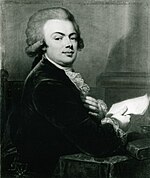This is an old revision of this page, as edited by WikiCleanerBot (talk | contribs) at 19:29, 30 September 2020 (v2.03b - Bot T5 CW#16 - WP:WCW project (Unicode control characters)). The present address (URL) is a permanent link to this revision, which may differ significantly from the current revision.
Revision as of 19:29, 30 September 2020 by WikiCleanerBot (talk | contribs) (v2.03b - Bot T5 CW#16 - WP:WCW project (Unicode control characters))(diff) ← Previous revision | Latest revision (diff) | Newer revision → (diff)
| Ludwik Skumin Tyszkiewicz | |
|---|---|
 | |
| Coat of arms | Leliwa – Skumin |
| Full name | Hrabia Ludwik Skumin Tyszkiewicz herbu Leliwa |
| Born | 1748 Vilnius, Grand Duchy of Lithuania |
| Died | 26 June 1808 |
| Family | Tyszkiewicz |
| Consort | Konstancja Poniatowska |
| Issue | Anna Maria Ewa Apolonia Tyszkiewicz |
| Father | Józef Skumin Tyszkiewicz |
| Mother | Anna Pociej h. Waga |
Ludwik Skumin Tyszkiewicz (Template:Lang-lt) (born 1748 in Vilnius – 26 June 1808) was a Polish–Lithuanian nobleman (szlachcic) and Field Lithuanian Hetman from 1780 to 1791, Great Lithuanian Treasurer from 1791, Great Lithuanian Marshal from 1793. Member of the Targowica Confederation.
In 1764, as an envoy from the Trakai Voivodeship he was an elector for Stanisław August Poniatowski, whose niece Konstancja Poniatowska, the daughter of Prince Kazimierz Poniatowski, he married in Warsaw on 4 April 1775. Their daughter Anna married Count Aleksander Stanisław Potocki.
In 1776, Tyszkiewicz was an envoy to the Sejm from the Vilnius Voivodeship. and in 1778 was made the Marshal of the Sejm. In 1782, he was a supporter of the Permanent Council. During the Polish–Russian War of 1792, on a meeting of 23 July, he supported the accession of the king to the Targowica Confederation, whose example Tyszkiewicz himself soon followed, becoming Grand Marshal of Lithuania. During the Grodno Sejm, he was chosen as a negotiator with the Russian ambassador Jacob Sievers, and so on 22 July 1793 he signed the treaty of the cession of land to Russia, and then on 25 September to Prussia, as part of the Second Partition of Poland. In 1795, he was the leader of the Lithuanian party paying homage to Catherine II.
On 25 November 1776, he received the Order of the White Eagle and in 1778 the Order of St. Stanislaus. Later in 1787 he also received the Russian Orders of St. Alexander Nevsky and of St. Andrew. In 1792, he had built the Tyszkiewicz Palace in Warsaw.
See also
References
- Akt elekcyi Roku Tysiąć Siedemset Sześćdziesiątego Czwartego, Miesiąca Sierpnia, Dnia dwudziestego siódmego.
- Volumina Legum, t. VIII. St. Petersburg. 1860.
{{cite book}}: CS1 maint: location missing publisher (link) - Volumina Legum t. X. Poznań. 1952.
{{cite book}}: CS1 maint: location missing publisher (link) - Бантыш-Каменский, H. H. (2005). Списки кавалерам российских императорских орденов Св. Андрея Первозванного, Св. Екатерины, Св. Александра Невского и Св. Анны с учреждения до установления в 1797 году орденского капитула.
| Lithuanian Field Hetmans | |
|---|---|
| 16th century | |
| 17th century | |
| 18th century | |
This biography of a Polish noble is a stub. You can help Misplaced Pages by expanding it. |
This biographical article about a member of the Lithuanian nobility is a stub. You can help Misplaced Pages by expanding it. |
- 1748 births
- 1808 deaths
- Secular senators of the Polish–Lithuanian Commonwealth
- Politicians from Vilnius
- Polish nobility
- Targowica confederates
- Tyszkiewicz family
- Field Hetmans of the Grand Duchy of Lithuania
- Grand Marshals of the Grand Duchy of Lithuania
- Grand Treasurers of the Grand Duchy of Lithuania
- Polish nobility stubs
- Lithuanian nobility stubs